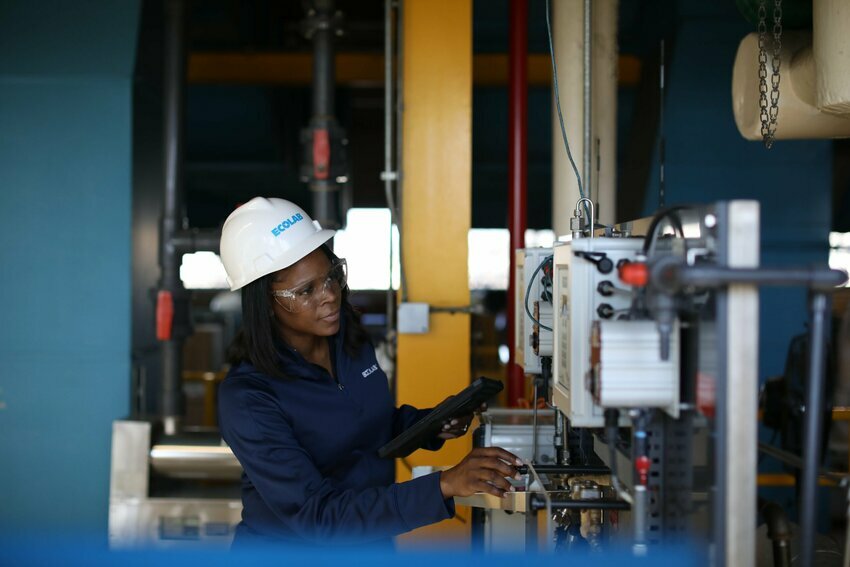 Ecolab is headquartered in St. Paul, Minnesota, and develops technologies to improve water treatment, purification, cleaning, and hygiene. Its goal is to optimize water and carbon impact, and improve operational efficiencies and sustainability for customers worldwide.
Ecolab is headquartered in St. Paul, Minnesota, and develops technologies to improve water treatment, purification, cleaning, and hygiene. Its goal is to optimize water and carbon impact, and improve operational efficiencies and sustainability for customers worldwide.
Between 2015 and 2017, it updated its aspirations, which center on water conservation and limiting heat-trapping emissions. In 2021, it helped conserve more than 215 billion gallons of water, saved 415 trillion Btus of electricity, avoided3.6 million metric tons of greenhouse gas emissions, and steered clear of 84 million tons of waste.
By 2030, it aims to achieve a positive water impact for its operations and customers. It wants to cut in half its carbon emissions by 2030. That equates to conserving more than 300 billion gallons of water and avoiding 6 million metric tons of greenhouse gases.
“Many companies have complex sustainability needs and aspirations,” said Emilio Tenuta, senior vice president, and chief sustainability officer. “Our industry-leading expertise and solutions help them reduce water and energy use for everything from industrial water boilers and cooling towers to ware-washing processes for restaurants and foodservice facilities. All of these individual interventions add up to a significant global impact.”
Ecolab says in its 2021 Sustainability report that 2 billion people live in water-stressed areas worldwide. It says 150 companies can directly impact a third of the world’s water use, making Ecolab’s mission vital to survival and sustainability.
Please explain the water challenges?
According to the World Resources Institute, there will be a freshwater deficit of 56% by 2030. There are a lot of competing interests going after limited water supplies — from agriculture to energy to fisheries. That compels Ecolab to be water positive — to return as much water as it consumes.
By 2030, it plans to reduce its water impact by 40% per production unit — using a 2018 base year. Similarly, it plans to restore more than 50% of its water withdrawals at high-risk sites.
In 2021, it said it reduced its overall water impact by 25% from a 2018 base year and restored 34% of its total water withdrawal at high-risk sites.
• In 2021, Ecolab helped fund a water conservation project to help secure 150,000 acre-feet of conservation (nearly 49 billion gallons of water) to shore up Lake Mead through the Colorado River Indian Tribe system conservation project, and
• In 2015, the Ecolab Foundation made a $2 million pledge to support The Nature Conservancy’s Securing and Restoring Water Sources Around the Globe initiative.
What about greenhouse gas reductions?
Ecolab’s midrange goal is to halve its carbon emissions by 2030 and to achieve net zero by 2050. It will achieve 100% renewable energy in its internal operations — something that requires the use of power purchase agreements and carbon credits, which are purchased from companies or countries that have exceeded their carbon-reduction goals. It is also working to align its suppliers with this mission — something it aims to achieve by 2024.
In 2021, it reduced its CO2 releases by 28%, using 2018 as a baseline. That references its Scope 1 and Scope 2 emissions — those tied to its internal operations and the electricity it buys from suppliers. It does not include Scope 3, which is linked to its supply chain. It also fueled its operations with renewables to the tune of 69%.
•. In 2019, Ecolab committed to the Science-Based Target initiative;
“In 2021, we invested over $1.2 million in continuous improvement projects focused on water and energy reductions at over 20 of our facilities across the globe,” Ecolab says. “In all, these projects reduced total energy consumption by almost 5.4 billion BTUs, reduced GHG emissions by 324 million tons of CO2 equivalents, and saved 27 million gallons of water across our global footprint.”
How are you reducing greenhouse gas emissions?
Ecolab points to the plant in Garyville, Louisiana, which installed an automated condensate return system: the energy savings was 3.8 billion BTUs. It also says its boiler automation systems in Japan and Mexico saved 430 million BTUs.
It partners with renewable energy producer Clearway Energy Group on its virtual power purchase agreement to get to 100% clean energy in the United States and Canada. Such an agreement involves buying the output of a given plant using long-term contracts. It is entering into such contracts with Low Carbon to do the same for its European plants.
“Combined, the two agreements allow us to source nearly 80% of our electric power from renewable sources,” Ecolab says. “In 2021, 69% of our total electricity usage was considered renewable setting us well on our way to achieving our goal of using 100% renewable electricity by 2030.”